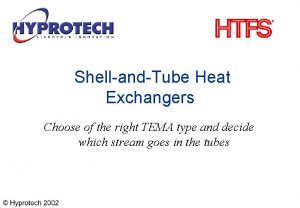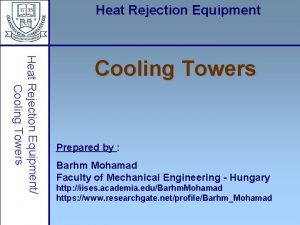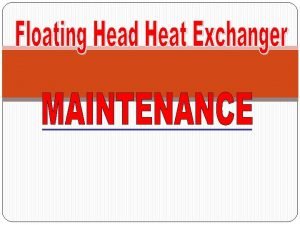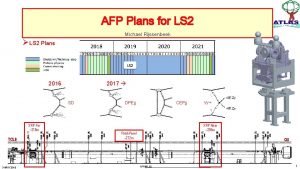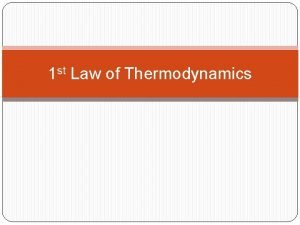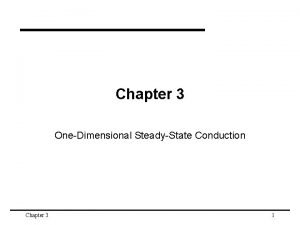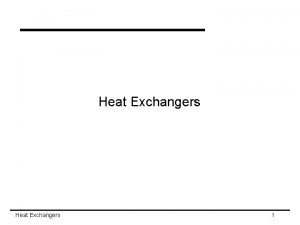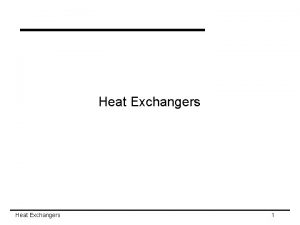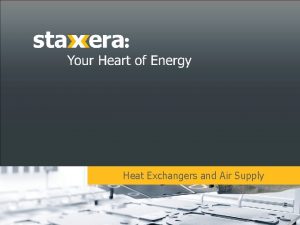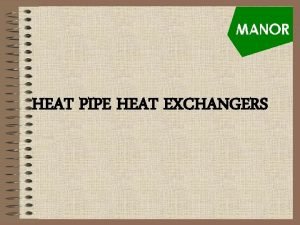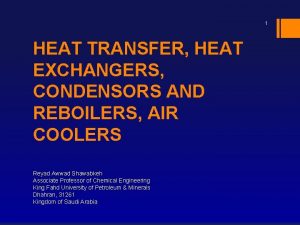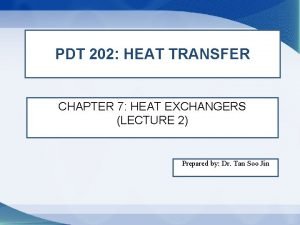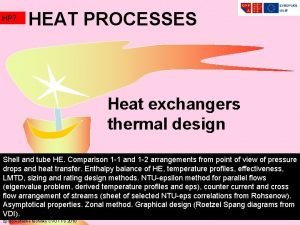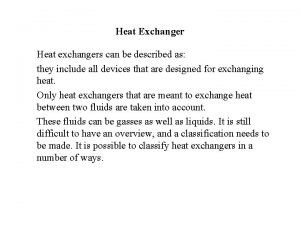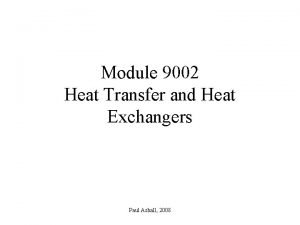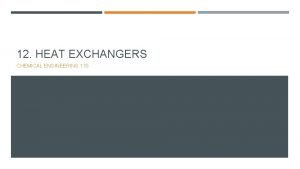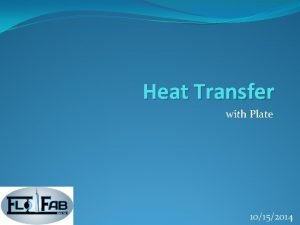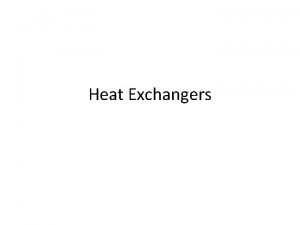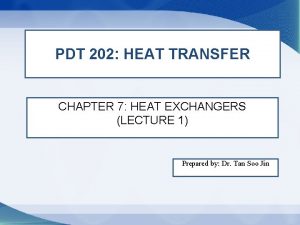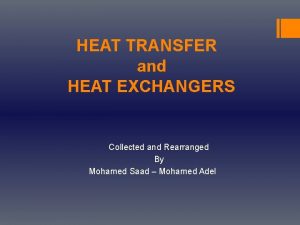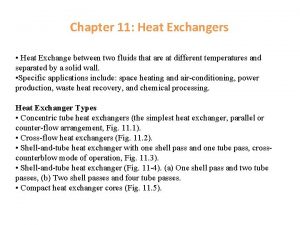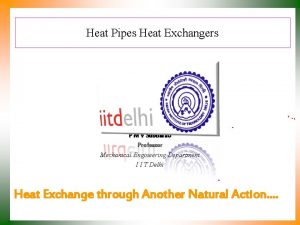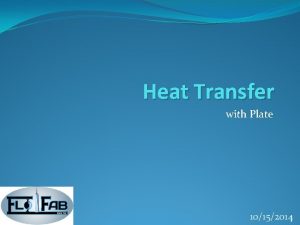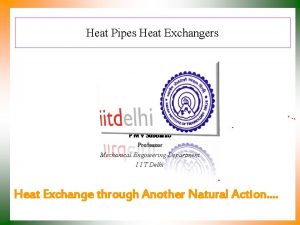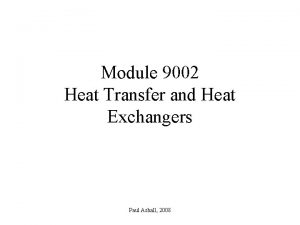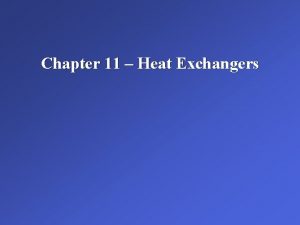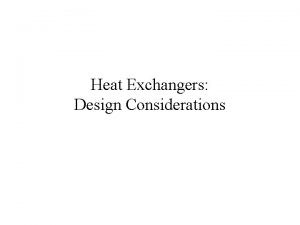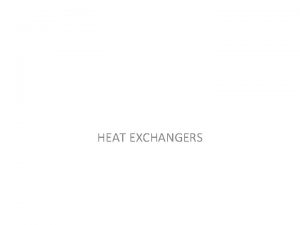Heat Exchangers Heat Exchangers Heat exchangers are one





























- Slides: 29

Heat Exchangers

Heat Exchangers • Heat exchangers are one of the most common pieces of equipment found in all plants. • Heat Exchangers are components that allow the transfer of heat from one fluid (liquid or gas) to another fluid. • In a heat exchanger there is no direct contact between the two fluids. The heat is transferred from the hot fluid to the metal isolating the two fluids and then to the cooler fluid.

Types of Heat Exchangers

Double-Pipe Exchanger

Double Pipe Simplest type has one tube inside another - inner tube may have longitudinal fins on the outside However, most have a number of tubes in the outer tube - can have very many tubes thus becoming a shell-and-tube

Shell-and-Tube Heat Exchanger

Shell-and-Tube Heat Exchangers are the most important type of HE. It is used in almost every type of industry. This type of heat exchanger consists of a set of tubes in a container called a shell. The fluid flowing inside the tubes is called the tube side fluid and the fluid flowing on the outside of the tubes is the shell side fluid.

Main Components of Shell-and-Tube Heat Exchangers

Some common heat-exchanger terms Tube side: Inside the tubes. Shell side: Outside the tubes, between the tubes and the shell. Tube sheet A thick plate provided with holes (one per tube) in which the tubes are fixed. Tube bundle Consists of tubes, tube sheet and baffle plates Shell A cylinder of plate in which the tube bundle is placed

l : t. C I I Ii ; r. J _, -)) . h : at r v l. m r. '. rm l , , 1 • . • I I , , heart Jnd 1 Cw 11 n-. , , l 'U 'Ji 1 e ra • Si 111 I . u "'1 t c h: , , 41 I 0 11 " , u, , c. • im, lr· 1 u 11 ' IUl rt. a. I I J 1 tll l 1 t 11 • r 11 llu • II v fl'. . 1111 tlilkrc 111 & l 1 1"C'1 11 nit • 11 111 t c " " " • . . r • · -. . . I' , ·, c. J 11 • r i & • ur n 1'1 k • I 1 l I I th: t

TEMA Heat Exchangers

Shell and Tube Heat Exchangers Construction Fixed Tube-sheet type U-tube type Floating Head type

Front head type A-type B-type A Channel and removable cover B Bonnet (integral cover)

Shell type E-type F shell F E One-pass shell Longitudinal baffle Two-pass shell

More shell types G and H shells normally only used for horizontal thermosyphon reboilers J and X shells if allowable pressure drop can not be achieved in an E shell G H Split flow J Longitudinal baffles Double split flow X Divided flow Cross flow

Low-finned Tubes Flat end to go into tube sheet and intermediate flat portions for baffle locations Available in variety of metals including stainless steel, titanium and inconels

Plate and frame Plates hung vertically and clamped in a press or frame. Gaskets direct the streams between alternate plates and prevent external leakage Plates made of stainless steel or higher quality material Plates corrugated to give points of support and increase heat transfer

Plate Heat Exchanger

Plate types Corrugations on plate improve heat transfer give rigidity Many points of contact and a tortuous flow path Chevron Washboard

General view of plate exchanger “Plate exchanger” normally refers to a gasketed plate- and-frame exchanger

Flow Arrangement within a PHE Gaskets arranged for each stream to flow between alternate plates Alternate plates (often same plate types inverted)

Air-Cooled or Fin-Fan Exchanger

Air-cooled exchanger Air blown across finned tubes (forced draught type) Can suck air across (induced draught) Finned tubes

ACHE bundle

Spiral Heat Exchanger

Spiral Heat Exchangers Spiral heat exchangers can be used in most applications in the chemical process industry In many difficult applications where fouling and plugging are problems, a standard shell and tube design may not be effective While a spiral heat exchanger often has a higher initial cost, it may provide a lower life cycle cost due to lower fouling rates and ease of maintenance

A spiral heat exchanger is composed of two long, flat plates wrapped around a mandrel or center tube, creating two concentric spiral channels In a spiral heat exchanger, the hot fluid flows into the center of the unit and spirals outward toward the outer plates while at the same time, the cold fluid enters the periphery and spiral inward, exiting at the center


 Mikael ferm
Mikael ferm Ddi heat exchangers
Ddi heat exchangers Split backing ring heat exchanger
Split backing ring heat exchanger Capacity of cooling tower
Capacity of cooling tower Scraped surface heat exchangers in food industry
Scraped surface heat exchangers in food industry Floating head type
Floating head type Michael rijssenbeek
Michael rijssenbeek Ddi heat exchangers
Ddi heat exchangers Nozzle and diffuser
Nozzle and diffuser One god one empire one emperor
One god one empire one emperor Little dog run
Little dog run One king one law one faith
One king one law one faith One empire one god one emperor
One empire one god one emperor One ford behaviors
One ford behaviors See one do one teach one
See one do one teach one See one, do one, teach one
See one, do one, teach one Night structure
Night structure See one do one teach one
See one do one teach one One vision one identity one community
One vision one identity one community One vision one identity one community
One vision one identity one community Specific heat capacity of lead j/kg c
Specific heat capacity of lead j/kg c Latent heat and specific latent heat
Latent heat and specific latent heat Moist heat method definition
Moist heat method definition Heat flowing out of earth as it cools
Heat flowing out of earth as it cools One dimensional steady state conduction
One dimensional steady state conduction Sin entered through one man
Sin entered through one man Metaphors in one direction songs
Metaphors in one direction songs Ones tens hundreds thousands
Ones tens hundreds thousands Othello sparknotes act 1
Othello sparknotes act 1 One team one mission
One team one mission


